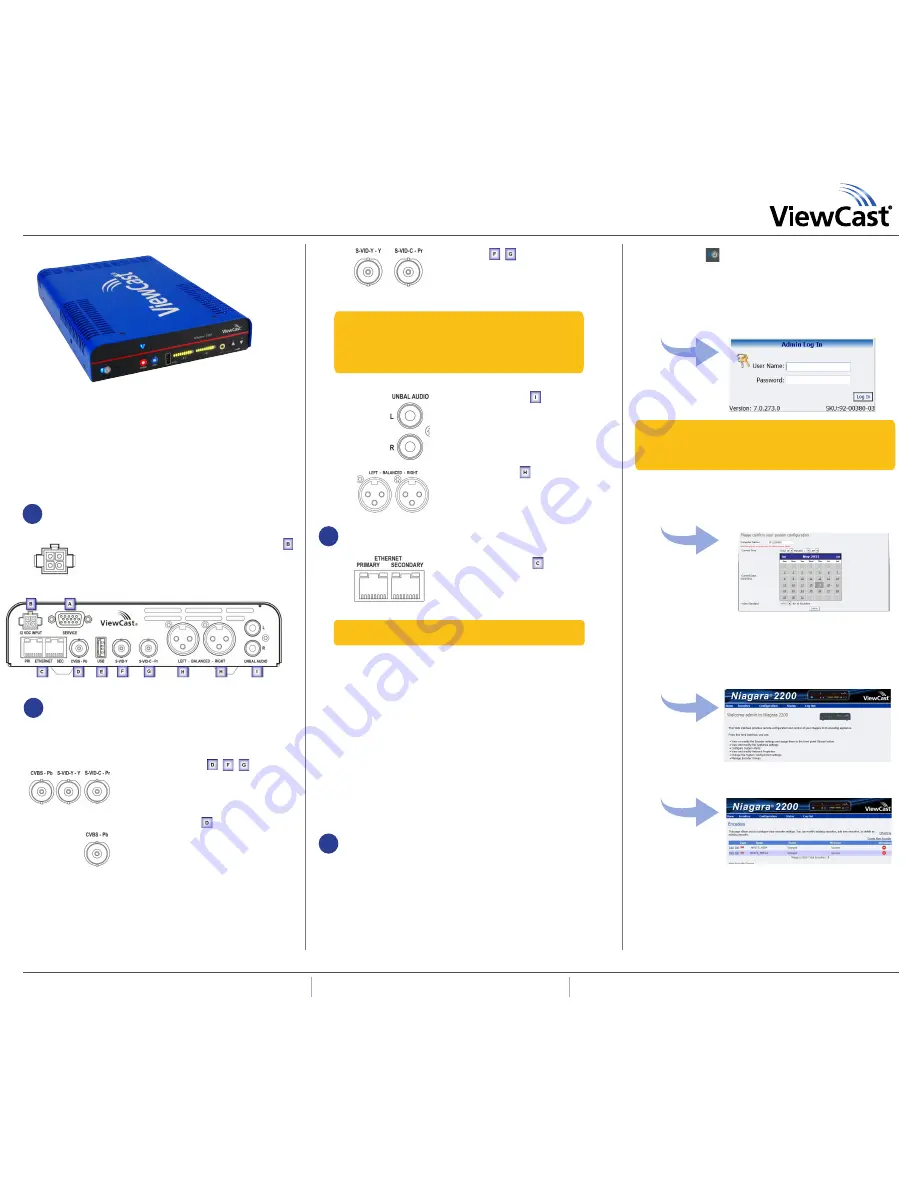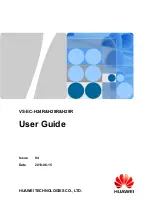
Quick Start Guide
Niagara
®
2200
Congratulations on the purchase of your new Niagara 2200.
The following steps in this
Quick Start Guide
will help you set up and
configure your Niagara 2200 so you can begin streaming or capturing
video as quickly as possible. The Niagara 2200 web interface also allows
quick and easy access to its operational features. You must modify any
advanced setup options of the Niagara 2200 encoders through this
interface before running an encoder session.
Complete the following steps to begin operating the Niagara 2200:
12 VDC Input for 100-240 volts, AC, 50-60 Hz
Plug the included power supply for the
Niagara 2200 into this connector and plug
the opposite end into an AC power source.
You may connect analog component, composite, or S-Video to the
Niagara 2200 as follows:
Component BNC Input , ,
The Niagara 2200 includes analog
component video BNC inputs.
Composite BNC Input
The Niagara 2200 includes a BNC-to-RCA
adapter so you can connect a composite RCA
video source to the BNC connector labeled
CVBS-Pb.
S-Video Input ,
You will find this standard consumer video
connector on most video players and video
cameras. This connection may require an
additional S-Video adapter (included).
NOTE:
Three BNC-to-RCA adapters are included with your
Niagara 2200. These adapt the Component and Composite
BNC connectors to a common RCA connector found on most
consumer video cameras and video players. Also provided is a
Y/C video adaptor for connecting an S-Video source.
Unbalanced Audio Input
These RCA connectors provide left and right ste-
reo inputs. RCA connectors (standard consumer
stereo audio connections) are on most video
players and video cameras.
Balanced Audio Input
These XLR connectors provide left- and right-
balanced stereo inputs. High-end audio and
video equipment may have these professional
connectors.
RJ-45 Ethernet Connector
The Niagara 2200 provides two network con-
nectors. Use either the primary
or secondary ethernet ports to connect to your
IP network.
NOTE:
Contact your network administrator for assistance
if you are unfamiliar with network protocols.
The Niagara 2200 network settings default to dynamically obtain an
IP address from a DHCP server on the network. For most network environ-
ments, you do not need to modify these default settings. If the Niagara 2200 does
not find a DHCP server or it remains unavailable on the network, the Niagara 2200
assigns its own IP address.
Once connected to a network, you should be able to access the built-in web
server by browsing to the unique machine name (the serial number is lo-
cated on the bottom or side of the appliance). You may also set the IP address
through the web interface.
If you do not have a DHCP network or you cannot connect to the Niagara 2200
through its DNS name, you can connect a monitor, mouse, and keyboard direct-
ly to the Niagara 2200 to USB ports. The Niagara 2200 will have a Microsoft®
Windows 7 desktop.
The first time you power on the Niagara 2200, the system takes a few moments
to boot up. From a separate computer on the same network as the Niagara
2200, launch a web browser such as Internet Explorer and enter the
IP address
of your Niagara 2200.
1)
Check to ensure you connect all devices (
power cords, video and
audio sources, etc.
) to the Niagara 2200.
2)
Press
Power
on the front panel to start the Niagara 2200.
3)
Browse to the Niagara 2200 from another computer on the
same network using Internet Explorer.
4)
Click in the
User Name
field and enter
admin
as the user name.
Then click in the
Password
field and enter
admin
as the
password. Finally, click
Log
In
or press
Enter
.
NOTE:
System administrators should previously configure all
user names and passwords for those who they allow to log
on to the system. The default login username and password
are
admin
.
5)
The first time you start the Niagara 2200 and log in, the system
prompts you for the date, time, and video standard. You may
accept the default date, time, and video standard or select your
own options, then select
Submit
.
6)
The system may re-display the
Admin Log
In
window again once
you submit the date, time, and video standard fields. You must
enter
User Name
and
Password
again.
7)
This time when you enter your valid user name and password,
the system displays the
Welcome
window and Niagara 2200
Main Menu
.
8)
To view available encoder profiles, from the menu bar click
Encoders
>
All Encoders.
9)
This example demonstrates how to create an MPEG4
stream. Click
Edit
to the left of the Flash encoder to open
the Encoder Properties window. Check to ensure the
video, audio, and streaming settings for the encoder
profile match your hardware setup using the Video, Audio,
and Output tabs. You may start a stream from the Encoders
window by clicking on
Start MPEG4 Encoder
in the upper
right area of the window.
Video
2.
Connect video and audio sources
Audio
3.
Connect to an IP network
4.
First start setup
1.
Connect to an electrical power source
Continued on back
Contact ViewCast Technical Support at
40-03330-01-A
© 2012 ViewCast Corporation. ViewCast
®
, Niagara
®
(and design)
TM
are registered trademarks of ViewCast Corporation
or its subsidiaries. All other trademarks are the property of their respective owners. Product specifications and availability
may change without notice.
US / Canada
+800-540-4119 | Europe / Middle East / 44 1256 345610 |
Asia / P852 2251 8778




















